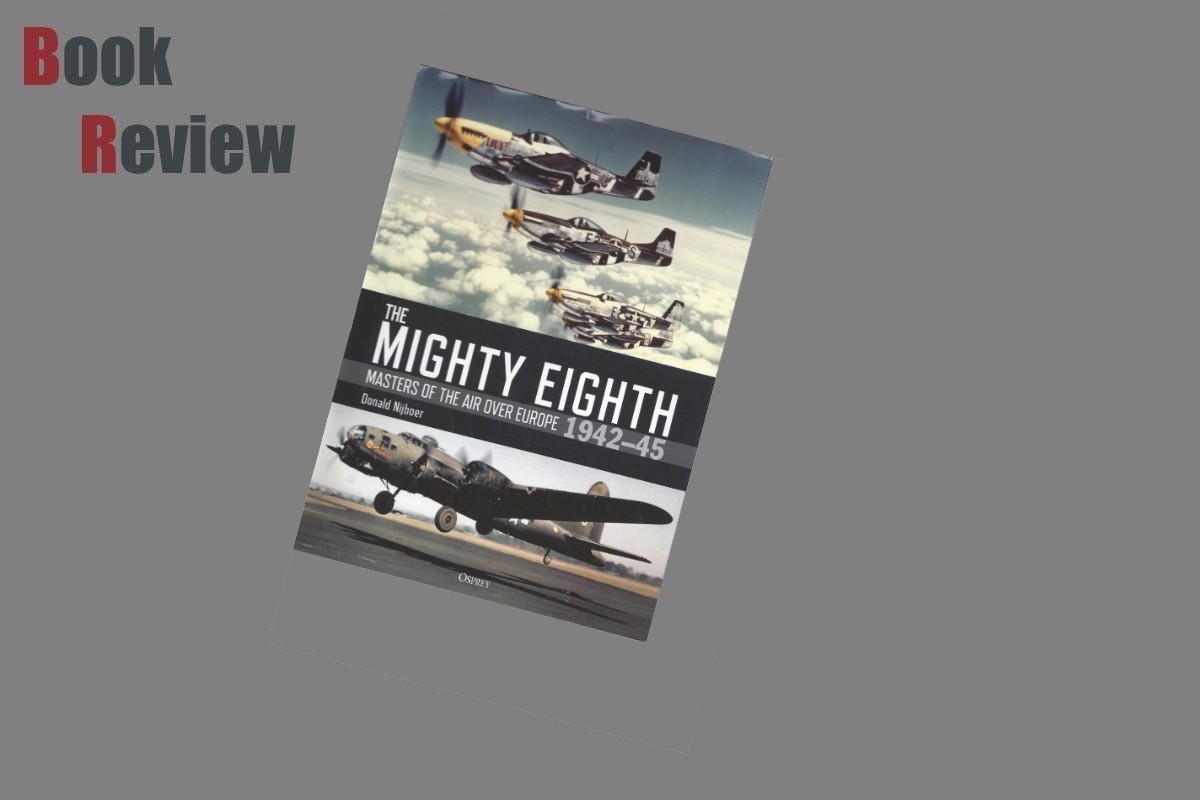Introduction
The Mighty Eighth Masters of the Air over Europe 1942–45 from Osprey Publishing presents a well-rounded look at the Eighth US Army Air Force. An exciting number of photographs in the book are original color. Authored by Donald Nijboer, this 320-page hardcover book is cataloged with Osprey’s Short code GNA, and as ISBN 9781472854216.
No doubt tens of thousands of pages have been written about the Eighth US Army Air Force (8thAF). After the end of the Cold War and with the advent of the internet, as governments began to declassify information and long-reticent veterans began to share their experiences, a new era of knowledge has challenged or confirmed what we previously understood about the Second World War in general, and the 8th AF in particular. Some books focus on generalities and broad overviews, some upon specifics. Some focus on operations. Some on weapons and equipment. Others on personalities, units or doctrines. This book attempts to present a balanced detailed exploration of all segments of the 8th AF as it took the war to the Nazi Reich. Osprey writes of this book:
The US Eighth Air Force—known as the "Mighty Eighth”—was a combat airforce activated in Georgia, USA on January 28, 1942. Its bomber command soon movedto Northern Europe to conduct strategic bombing missions, seeking to destroy Germany's ability to wage war. Among the major operations it participated in were "Big Week” in February 1944; the D-Day landings in June 1944; and the defeat of the Luftwaffe and destruction of German industry. Eighth Air Force was the largest of the deployed combat Army Air Forces in numbers of personnel, aircraft, and equipment. At peak strength, Eighth Air Force had 40 heavy bomber groups, 15 fighter groups, and four specialized support groups.
This work provides a superbly illustrated and fully comprehensive exploration of the Mighty Eighth's bomber and fighter planes, its incredibly brave pilots and crew, and its daring and dramatic operations. It also explores the careers of key personalities associated with the Mighty Eighth, such as Earle Partridge, James Doolittle, and William Kepner. Packed with hundreds of color aircraft profiles, battlescene artworks, and period photographs, The Mighty Eighth provides a truly comprehensive look at the illustrious history of the US Eighth Air Force.
I do not know how Osprey is related to Apple but they tell us:
The perfect companion to Masters of the Air on Apple TV+, this is a superbly illustrated examination of the aircraft, pilots, crews and operations of the US Eighth Air Force.
What I am impressed with is the degree that the author blends so many aspects of the 8TH AF's time in WW2 into a single volume. This is not just a flight-n-fight book, nor is it merely images of cool airplanes and equipment. Far beyond dry factual text, some parts seem more like a "letters from..." genre. For me, it goes beyond simple knowing and helps with understanding. What I will say is that as a modeler, this book is a treasure trove of images and source material, whether for individual aircraft or personnel equipment, or for dioramas. You can find it here at Osprey's website.

Table of Contents
The Mighty Eighth is presented through seven chapters and several subsections in 320 pages:
Introduction
Genesis
VIII Fighter Command
Chapter 1: The Friendly Invasion:"Over Paid, Over Sexed, and Over Here!”
Strategic Air Depots
Daily Life and Conditions of Service
Easily Replaced
Love, London, and Longing
Tents and Castles
"Consider Yourselves Already Dead”
Chapter 2: The Light of Day: The USAAF Strategic Bombing of Germany 1942-45
1942: First Missions
1943: A Decisive Year
1944: Winning the Argument
1945: Crippling Nazi Germany
Chapter 3: Organization of Eighth Air Force: Air and Ground Units
Air Units
Ground Crews and Personnel
Eighth Air Force order of battle, January 1945
Chapter 4: Aircraft of the Eighth Air Force: Bombers, Fighters, Reconnaissance
Bombers
Fighters
Photo-recon and Reconnaissance
Chapter 5: The Tools of Battle: Training, Formations, Technology, Armament, Tactics
Training
Formations
Technology
Armament
Fighter Tactics
Chapter 6: The Experience of Battle: Facing the Flak, Dueling the Fighters
Enemy Coast Ahead
12 O'Clock High
Receiving Flak
Bailing Out
Air Sea Rescue
Returning Home
Relief and Debrief
Casualties
Combat Focus: 303rd Bomb Group "Hell's Angels”
Fighter Mission
Combat Focus: 4th Fighter Group "Debden Eagles”
Combat Focus: 56th Fighter Group
The Opposition: Defending the Reich
Chapter 7: Eighth Air Force Personnel: Leaders and Aces
Senior Leadership of Eighth Air Force
Heroes at the Sharp End
Chronology
Further Reading and Research
List of Acronyms and Abbreviations
Acknowledgments
Index
Content
The book is smartly organized and written in an easily read conversational style. Call out boxes highlight unique information, i.e., Trolley Runs, a photo of Cologne with a description of the program that took ground personnel sight-seeing over Germany to witness the results of their contribution to defeating the Nazis; The Mental Toll is another relating the psychological wounds aircrew suffered. Large books - both in page size and count - like The Mighty Eighth are more difficult for me to review as the sheer volume of content cannot be reasonably covered. I will try to present parts that strike me as new or unique. I counted 39 sections in the seven chapters listed above. That includes the 16-page Introduction, which focuses on the Boeing Model 299 and its development into the B-17, continuing to the formation of bomber and fighter commands, thence the hellscape of the air war, to the arrival of the P-51. A range map of fighter escort accompanies the text, as do reproductions of graphics of German fighter effectiveness into1944.
The Friendly Invasion provides amusing and poignant looks at the 8th AF. Statistics of note include the cubic yards of earth and concrete required to build a bomber base, including the number of trees and miles of hedgerows requiring removal; a limited coal ration per week for heating a barracks. The size of the logistics train is interesting. Cultural anecdotes include the confusion of an American on leave, lost and seeking help, being told to “knock someone up.” Living quarters varied from muddy tents to castles.
The Light of Day looks at the evolution of 8th AF from arrival in Britain through becoming an effective combat force, and everything that it took to do so, including the RAF helping to retrain USAAF gunners. It moves through the fortunes and foibles of 8th AF, and those of the Luftwaffe. Sortie rates and expansion of aircraft per bomb group, numbers and statistics of kills and losses, and descriptions of tactics are presented.
Organization of Eighth Air Force sub-chapters include statistics on the composition of a bomber/fighter base:
- Flying group and squadrons, and Service unit
- Number of aircraft and number of reserves
- Average base personnel
- Fuel storage
- Bomb tonnage storage.
Medical units and ground echelon are described, as well as:
- Ordnance, Supply, and Maintenance
- Fire and Facilities
- Rest and Religion.
Each section mentions occupations known or assumed (Provisional Gas Detachment, Finance Section, ‘Detachment 107’ - not explained), and some I never thought about in combat group - handymen, painters; plumbers, tailors, etc.
Aircraft of the Eighth Air Force takes a good look at 8th AF aircraft. Beyond performance and numbers built, and operational histories, the author describes technical trivia, i.e., types of turrets and propellers used, construction materials and methods. Each significant variant and version is described. Included is trivia, i.e., a B-17’s maximum internal cross-section height and width; the number of design changes made between some variants. Each aircraft section includes a table of typical basic size and performance specifications (not mentioned below in Graphics). A call out boxes focuses on P-47 External Tanks (color photo) and K-14 Gunsight View (artwork).
The Tools of Battle is a pleasant surprise to me. It presents information usually only found in individual biographies or very focused and specific subject matter books. We learn of the expansion of pre-war aircrew training, and methods of selection and training of aircrew and ground crew. Tactics is particularly interesting as it includes first-hand accounts by a Luftwaffe Flight Test Center pilot, and 56th FG CO “Hub” Zemke, who wrote of the P-47:
A rugged beast with a sound radial engine to pull you along, it was heavy in firepower- enough to chew up an opponent at close range. It accelerated poorly and climbed not much better. But once high cruising speed was attained, the P-47 could stand up to the opposition. Strangely, the rate of roll and maneuverability were good at high speeds. At altitude, above 20,000 feet, the P-47 was superior to the German fighters.
That excerpt is short compared to other first-hand accounts by other pilots. Those are pilots who flew the P-38, P-47, or P-51 with the 8th AF. Some challenge today’s conventional wisdom such as part of three pages of points written by the CO of the 20th FG concerning offensive and defensive fighting against the Luftwaffe in a P-38:
1. The P-38J will out turn any enemy fighter in the air up to 25,000ft, so we wait until he is about one-half to one mile in back of us and then turn I into him. 2. After the turn we generally can attack him. If he zooms up, we climb until he breaks down, when we attack. If we cannot outclimb him we continue on our course (opened up, line abreast) and let him make another pass if he so desires. Eventually he will break down and then we attack.
Next, The Experience of Battle takes us through a thorough description of a mission from initial alert of a potential mission, through awaking, all the personal and technical preparations for the job, take-off and forming up; combat in all of its guises; bailing out or returning home, through de-briefing. If that is not fascinating enough, the sub-chapters Combat Focus and The Opposition are also amazing.
Lt. Crockett’s ship directly in front of us took a direct hit in the cockpit. Chunks of flesh came back at us, across our windshield. My co-pilot became ill. Crockett’s ship seemed to come to a complete stop. Since I was directly behind him, with wingmen on both sides, I could not turn. I chopped throttles and “fish-tailed” the bird, praying I’d miss the stricken ship. Somehow, it seemed to float over my wingtip and was gone.
Eighth Air Force Personnel: Leaders and Aces offers a concise look at the major commanders and most notable pilots. We learn about their backgrounds and early career experiences, and war roles. Gabreski, Zemke, Spatz, Johnson, to name a few. The book ends with a fairly lengthy end matter: Chronology; Further Reading and Research; List of Acronyms and Abbreviations, etc.
Thus ends this glimpse of what information this book offers. Now to look at the visual component.
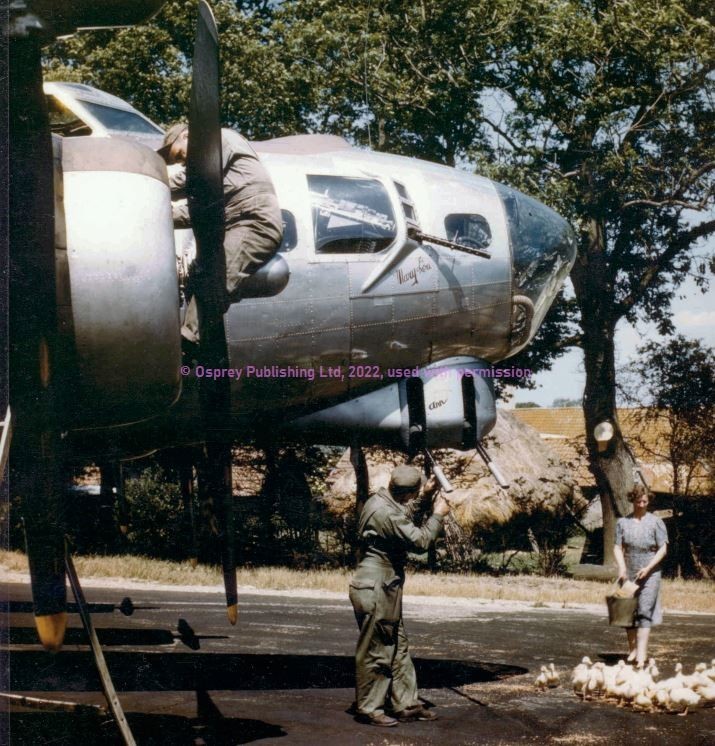
Photographs, Artwork, Graphics
As previously mentioned, reproductions of original charts and diagrams support the text, along with images created for the books. Each is accompanied by captions or narratives of varying detail.
Photographs
Maybe the term is overused but the text is richly supported with photographs. Not just the gray scaled black-and-white but dozens of original color exposures. Many photos will be familiar with readers who have read other European air war books, and yet the author has dug up many new photos – for me at least – of the air war. Images of the crucible of combat, images of rear area rest and recreation. Aircraft, personnel, equipment, and idyllic scenes. One of the remarkable B/W photos is of a Focke-Wulf 190 (Fw 190) head-on through bombers, smoking after being hit by defensive fire.
Artwork
Scores of graphics enhance the book. No particular artist is credited for this title because, while some illustrations may be original commissions for it, many are reused from other related Osprey titles. Nothing wrong with that, and each illustration is credited to its artist. The artwork consists of three main subjects: aircraft or equipment profiles; dramatic combat action scenes; explanatory diagrams.
Action scene B-24 of 93rd Bomb Group, October 9, 1942: two-page artwork of a B-24 absorbing 200 hits before returning home.
Action scene Outbound to Schweinfurt, August 17, 1943: two-page artwork of a checker-nosed Focke-Wulf head-on into the 91st BG.
Action scene Thunderbolt Interception, August 17, 1943: two-page artwork of a P-47 destroying a Bf 110.
Action scene of P-51Bs peeling off after attacking Fw 190s: two-page artwork.
Action scene The YB-40 in Action: two-page artwork of a gunship killing a Fw190.
Action scene Eighth Air Force’s First “Deep Penetration” Bombing Mission: two-page artwork of a Fw 190 head-on through B-17s.
Action scene P-47 Thunderbolt vs Bf 109G/K: two-page artwork of a dogfight overB-17s.
Action scene Airborne Rocket Attack, October 14, 1943: two-page artwork of Bf110Gs barraging B-17s with Wfr. Gr. 21 rockets.
Action scene Mustang vs Me 262: two-page dramatic scene of Me 262 pilot bailing out.
P-47D-25 Wing Guns: overhead cutaway.
P-51B/C Guns: overhead cutaway.
P-51D/K Guns: overhead cutaway.
B-17G Cheyenne Tail Turret: overhead cutaway identifying nine components.
B-17G Cheyenne Tail Turret: crewman’s interior view identifying 18 components.
B-24D Liberator Nose Compartment: crewman’s interior view identifying 27 components.
The Fields of Fire of a B-17G: planform showing arcs of gunnery.
Plan and Profile Views of B-24D Fields of Fire.
P-47D-25 cockpit: pilots-eye view of the cockpit, keyed with 66 components.
P-38J of Robin Olds, 434th Fighter Squadron, June 1944: profile of Olds’ first P-38.
P-38J of Capt. Lindol F. Graham, 79th Fighter Squadron, March 1944 in profile.
P-51D cockpit: pilots-eye view of the cockpit, keyed with 69 components.
Fw190 Engages a B-17: pilots-eye view from the cockpit.
K-14 Gunsight View: a Fw 190 through the gunsight.
B-17F Armament Forward Compartments: full-color reproduction from the B-17F Familiarization and Inspection Manual.
B-17G Replenishing Diagram: color USAAF page showing the fuel and oil system.
Profile: P-51B of Capt. Don Gentile, March 1944.
Profile: P-51K-5, Maj. “Kit” Carson, 362nd Fighter Squadron, December1944.
Profile: Shangri-La, P-51B-5, Capt. Don Gentile, March 1944.
Profile: Spitfire VB, 1Lt Don Gentile, 336th FS, Oct. 1942.
Profile: P-47C, 2Lt Kenneth Peterson, 336th FS, June 1943.
Profile: P-47D of Capt. Gabreski, 61st FS, Sept. 1943.
Profile: P-47D-11, Lt-Col. Francis Gabreski, 61st FS, January 1944.
P-47D-25, Lt-Col. Gabreski, 61st FS, June 1944: profile; planform; head-on.
Profile: P-51D, Lt-Col. John C. Meyer, 487 FS, Dec. 1944.
Profile: P-51B-5, Col. Don Blakeslee, March 1944.
Profile: P-38J, Lt Victor Wolski, 436th FG, May 1944.
Profile: B-17G 42-39775 Frenesi, 333 BS, 94th BG, January 1944.
Profile: UC-64 Norseman, 56th FG, April 1945.
Profile: P-47D of Lt. Robert Johnson, 61st FS, Feb. 1944.
Profile: PR XVI Mosquito: RF992/R, 654th Bomb Squadron, 25thBomb Group, 325th Photographic Wing, March 1945.
Profile: P-38J, Capt. Arthur Jeffrey, 434th FS, July 1944
Profile: P-51D, 1Lt Urban Drew, 375th FS, 361st FG, Oct. 1944.
Profile: P-47M, Maj. George Bostwick, 63rd FS, March 1945.
Profiles: Flakzwilling 40/2; FlaK 18 Fixed High Explosive (HE) 88mm Shell.
Callout box: Finger-Four Formation.
Callout box: USAAF Combat Wing Formation.
Callout box: New Luftwaffe Weapons.
Graphics
Original and current charts, tables, graphs, schematics:
Bomb Types: six bombs used by 8th AF.
Eighth Air Force Commanding Officers.
Eighth Air Force Awards and Decorations, August 17, 1942-May 15, 1945 lists numbers awarded for:
· Medal of Honor
· Distinguished Service Cross
· Distinguished Service Medal
· Legion of Merit
· Silver Star
· Distinguished Flying Cross
· Soldier’s Medal
· Purple Heart
· Air Medal
· Unit Citation.
Bar graphs of German fighter effectiveness into 1944.
Range map of P-47 escort fighters, May 1943-February 1944: showing effects of different fuel configurations.
Luftwaffe identification manual showing a three-view of a B-17 identifying fuel tanks, armor, and armament.
Total ammunition fired by B-17 and B-24 gun positions: taken from an USAAF Operational Analysis Section publication.
Size of Bullet Patterns of B-17 Guns: dispersion at 600 yards from the seven gun positions.
Attacks and Hits on B-17s and B-24s January-May 1944: four schematics of fighter attacks against bombers by the 8th AF.
B-17 Formations, 1943: 3-view of a squadron; profile of a group.
Me410: color cutaway by British Air Intelligence showing vulnerabilities.
Frequency, Cause and Location of Fires on Lost Bombers: complied by the Operational Analysis Section.
Frequency of Loss and Damage to Heavy Bombers Due to Enemy Fighters: through March1944.
Eighth Air Force Order of Battle, January 1945: five pages of Command and Control; Air Divisions and subordinate Wings, Groups and Squadrons; Special Operations; Scouting Forces; Rescue Group; Flight Training.
US Escort-fighter ranges: Range map and table of P-38, P-47, and P-51 escort fighters, May1943-March 1944: showing capabilities of 11 different fuel configurations.
P-51 Ranges: Range map showing capabilities of three fuel configurations.
Eighth Air Force Enemy Aircraft Claims in the air and on the ground, for the P-38/P-47/P-51/Spitfire, and claims verses losses.
Luftwaffe Fighter Mass Attacks: two overhead views of Zerstörers attacking with Wfr. Gr. 21 rockets, and single-engine fighters coming head-on.
Flak Analysis by USAAF.
Air Sea Rescue, Jan. 1943-Apr. 1945: numbers of crew bailed out or ditched; rescued; percentage by B-17; B-24; P-38; P-47; P-51.
The Changing Size and Character of Heavy Bomber Operations: large multi-subject graphic for 1942-1944.
Direction of Attack: by 8th AF covering fighter attacks.
Eight Air Force Heavy Bomber Losses, August 1942-Sept. 1944.
Top Aces of the Eighth Air Force: top 16.
Just listing the visual graphics of this book took longer than some full reviews I've written. Suffice it to say there is a lot to feast your eyes upon.

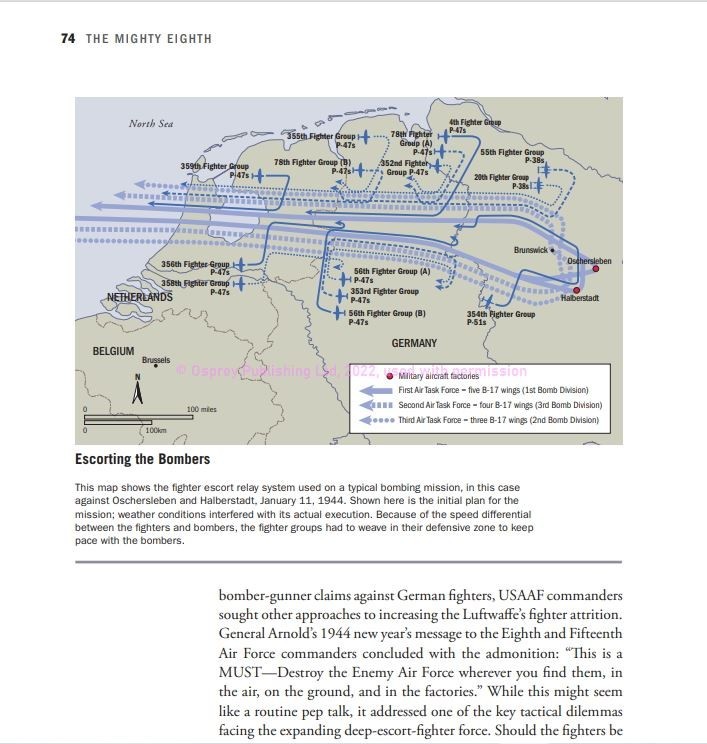
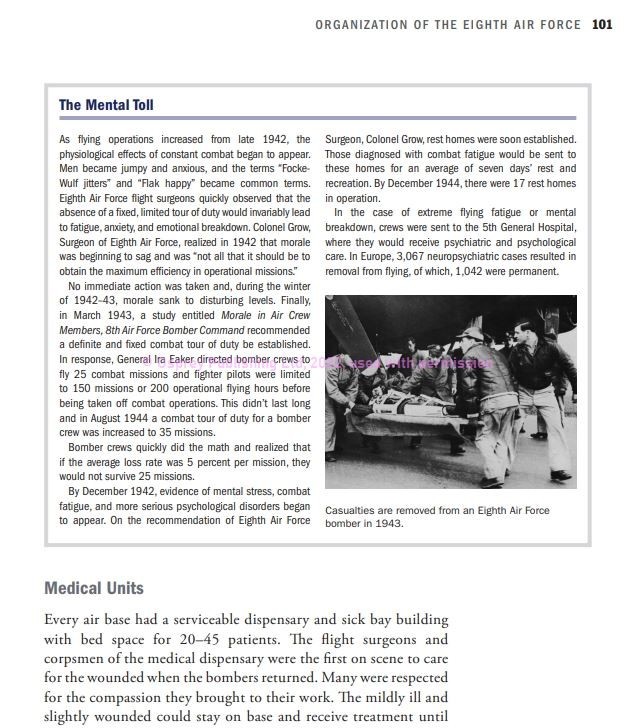

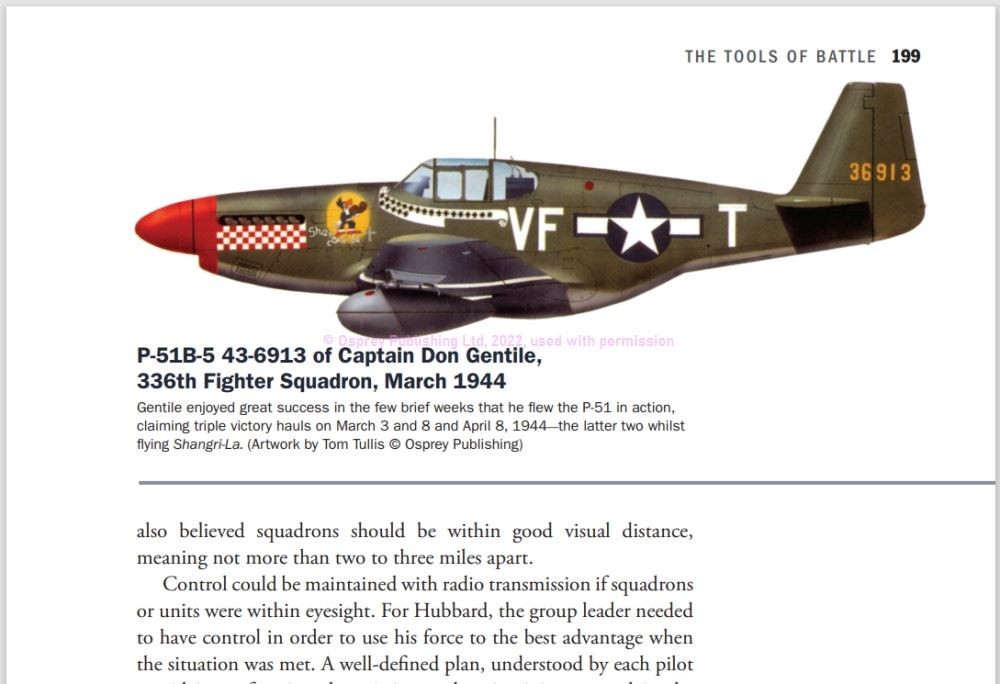


Conclusion
With The Mighty Eighth, Osprey offers modelers and historians a great deal of information to stoke our imaginations, springboards for more in-depth research, and source material for our research. The number of original color photographs is impressive outside of a “in color” book. Content flows easily with an organized layout. Chapters and subsections offer exposure to topics not always discussed outside of specialty books. Illustrations, maps and informational tables and charts are useful. Color artwork captures what the cameramen of the time did not. Examples from official documents and primary sources are high points of the book’s graphic component.
Do you build models because you desire a physical representation of what you read about, or do you read to understand the models you build? Regardless, I believe that for a modeler, this book is a treasure trove of images and source material, whether for individual aircraft or personnel equipment, or for dioramas. Recommended.
Please remember to mention to Osprey and retailers that you saw this book here - on Aeroscale.










